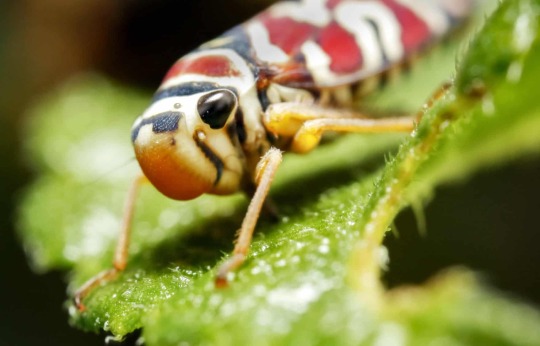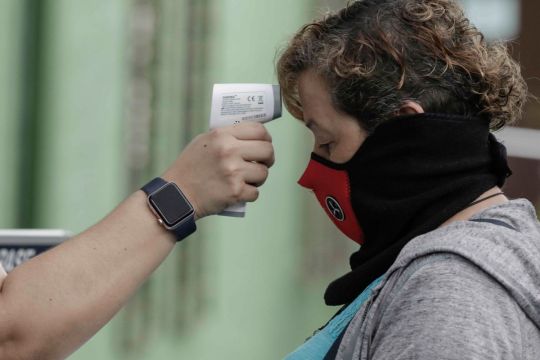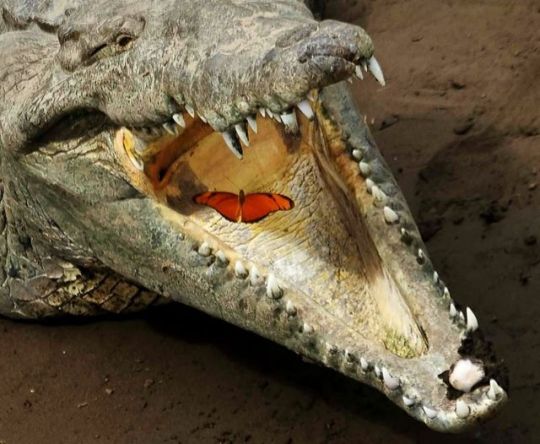#jeffrey arguedas
Text

A leafhopper, east of San José, Costa Rica. The Unesco office in Central America has urged the region to value its rich diversity and to work to restore the links between humans and nature, as well as to take actions to protect species and ecosystems
Photograph: Jeffrey Arguedas/EPA
26 notes
·
View notes
Text
Após ficar mais de 100 horas incomunicável, ativista é localizada na prisão mais dura da Venezuela
A ativista Rocío San Miguel Sosa em audiência na Corte Interamericana de Direitos Humanos (CIDH) contra perseguição da ditadura de Maduro| Foto: EFE/Jeffrey Arguedas
A Justiça da Venezuela decretou a prisão preventiva da ativista venezuelana Rocío San Miguel na última sexta-feira (9) por estar supostamente ligada a uma conspiração para assassinar o ditador Nicolás Maduro e outras autoridades,…

View On WordPress
0 notes
Text
La IA constata que hay más especies de reptiles en peligro de extinción
En la imagen de archivo, una serpiente coral (Micrurus nigrocinctus nigrocinctus). EFE/Jeffrey Arguedas Redacción Ciencia | 26 may. 2022 Las especies de reptiles que no figuran en la Lista Roja de la Unión Internacional para la Conservación de la Naturaleza (UICN) tienen más probabilidades de estar amenazadas que aquellas evaluadas, según una investigación que ha […]La IA constata que hay más…

View On WordPress
0 notes
Photo

A butterfly flies into the jaws of a crocodile in the Tárcoles River, Costa Rica – the most polluted basin in Central America and one of the most polluted in Latin America
Photograph: Jeffrey Arguedas/EPA
#nature#wildlife#animals#life#infraganti#butterfly#jaws#crocodile#mariposa#cocodrilo#tarcoles river#river#costa rica#basin#pollution#central america#latina america#jeffrey arguedas#epa#the guardian#the week in wildlife
7 notes
·
View notes
Photo

Photograph: Jeffrey Arguedas
#surf#wave#sea#Photography#Lensblr#Photo#Art#Aesthetic#Camera#Curators on tumblr#Reblog#Pic#Nature#Peace#Peace Photography#Travel
242 notes
·
View notes
Photo

Honduran white bats hang on to as leave in the forested area of Guápiles, Costa Rica.Photograph: Jeffrey Arguedas/EPA.
The Honduran white bat (Ectophylla alba), also called the Caribbean white tent-making bat, is a species of bat in the family Phyllostomatidae. It is the only member of the genus Ectophylla. The genus and the species were both scientifically described for the first time in 1892. It has distinctive, entirely white fur, which is only found in six of the roughly 1,300 known species of bat. It constructs "tents" out of understory plant leaves by strategically cutting the leaf ribs with its teeth; it roosts in these tents during the day.
96 notes
·
View notes
Photo

View of a coati, part of the fauna that makes up one of the biological corridors in Upala. The corridors, which cover 33% of the territory of Costa Rica, are a bridge for biodiversity conservation and also contribute to the sustainable development of rural communities
Photograph: Jeffrey Arguedas/EPA
(via The week in wildlife – in pictures | Environment | The Guardian)
#White-nosed Coati#Nasua narica#Nasua#Procyonidae#Musteloidea#Caniformia#Carnivora#Mammalia#mammal#coatimundi#Costa Rica
15 notes
·
View notes
Text
Fungi
The Earth’s Secret Miracle Worker is Not a Plant or an Animal: It’s Fungi
Without fungi we don’t have bread, chocolate, cheese, soy sauce, beer or wine. They are also crucial to protecting our climate
— Giuliana Furci | Thursday, 11 November 2021

‘Fungi are responsible for almost all our food production, and most of our processed materials. They can also be thanked for many medical breakthroughs in human history.’ Photograph: Jeffrey Arguedas/EPA
Let’s picture a dinner with family or friends that began by enjoying beer, wine, fruit juice or maybe a fizzy kombucha beverage. You’re contemplating a glorious basket of bread, wrapped in awe of its perfect crumb and fantasizing about the moment you slather it in butter or olive oil. Then come the fresh vegetables sauteed with soy sauce, maybe tofu or free-range beef with potatoes or rice, followed by cheese, or a chocolate dessert – and to top it off, a lovely cup of coffee or tea with some chocolates or maybe some sake? We need to stop for a moment and thank fungi for all of this. Honestly, none of it would be possible without them, and your dinner would certainly not be so tasty!
Fungi are responsible for almost all our food production, and most of our processed materials. They are also to be thanked for many of the important medical breakthroughs in human history that treat both physical and mental ailments, for naturally sequestering and slowly releasing carbon, for optimizing industrial processes, and so much more.
When most people think about fungi, they tend to associate them with decay. Many people mistakenly believe fungi are plants. However, fungi are neither plants nor animals but rather organisms that form their own kingdom of life.
The way they feed themselves is different from other organisms: they do not photosynthesize like plants and neither do they ingest their food like animals. Fungi actually live inside their food and secrete enzymes to dissolve nutrients they then absorb.
Included in this kingdom are yeasts, moulds, mushrooms, wood-ears or conks, and several other different types of unicellular and multicellular organisms that live in marine, freshwater, desert and both young and old ecosystems on Earth. Basically, a morel and a chanterelle are as closely related as a flea and an elephant. The latter are both animals, the former are fungi.
Interestingly, fungi are more closely related to us animals than to plants, sharing a common ancestor in the form of an opisthokont, which is a cell with a posterior flagellum – like human spermatozoids.

‘We know only 10% of species diversity within kingdom fungi, at most.’ Photograph: Robin Loznak/ZUMA Press Wire/REX/Shutterstock
Now to the central question: what would happen in a world without fungi? Most plants can’t live outside water and rely on fungi to survive. There would be no forests for you to hike in or any agriculture to feed you. Herbivores such as cows can’t break down grass without the fungi in their gut. Fermentation is possible only because of yeasts, which, going back to our dinner table, means that no fungi would mean no bread, no chocolate, no soy sauce, no beer or wine. Hence our gratitude for fungi at dinner.
Moreover, without moulds like koji many ancient civilizations could not have preserved food, other than using salt or smoking (imagine that for a second). For decades we have extracted enzymes from fungi to clean clothes in cold water (yes, it’s fungi that do that in your detergent), have bioengineered natural pesticides with entomopathogenic fungi that eliminate the toxic burden of synthetic pesticides, and have learned to use some species to maximize the amount of metal extracted from rocks in mining processes.
We have also discovered the cholesterol-lowering statins in fungi, life-saving antibiotics like penicillin, the medicines that allow for organ transplants to be successful, and we are now finally accepting and legalizing medicinal compounds made by fungi to treat urgent and life-threatening mental health ailments such as PTSD and depression.
As if that weren’t impressive enough, our ancestral and traditional ways of ritually reaching the celestial from the terrestrial almost all include fungi – from the ritual beverage Soma in Vedic cultures to communion with bread and wine in Roman Catholic cultures. Fungi matter – a lot.
Nevertheless, the entire kingdom is ignored in most biodiversity, climate change and environmental legal frameworks. And by the general public too: for too long macroscopic diversity and species on earth have been referred to using the now obsolete term flora & fauna, or just plants and animals instead of fauna, flora & funga, or animals, fungi and plants.
The third “f”, representing fungi, is acknowledged as the correct term to refer to the diversity of fungi of a given place. The IUCN species survival commission and the global NGO Re:Wild – among others – have adopted this terminology. It seems the time has finally come to leave mycological illiteracy behind.
***
Decomposition, or decay, is the very beginning of a fundamental natural process that enables life. There is no regeneration without degeneration of organic compounds, because energy is not lost, it is transformed – and it is the fungi that are heavily responsible for this vital transformation. For example, if we look at a fallen tree in the forest and imagine it is composed of building blocks, we can understand how decomposition works: fungi weave their way through the blocks, loosening them until they are “free” and ready to “rebuild” in another form.

‘Decomposition is the beginning of a fundamental natural process that enables life.’ Photograph: Yarygin/Shutterstock
For too long this process has been considered distasteful, under the once-upon-a-time understanding that life is a linear process. It is shocking to think that we can attribute any negativity to rot when we understand the incredible nature-based solutions it holds.
We can use rot for a more sustainable future too. For instance, mycelium – a mostly invisible group of fungi, such as mushrooms and conks – is a tangible and safe alternative to animal leather as well as plastic packaging, and is starting to revolutionize the fashion industry. Mycelium leathers and packaging are offering the opportunity to use fungi involved in decomposition as a source of clothing and durable, recyclable and natural materials that are more sustainable to produce.
The rice of the sea: how a tiny grain could change the way humanity eats
Materials like Mylo Unleather and Made with Reishi, as well as incredible packaging materials made by Ecovative, are trailblazing for industry to move away from pollutant materials whose manufacturing process requires unsustainable amounts of water, toxins, and energy, and sometimes requires the end of an animal’s life.
As legendary mycologist Paul Stamets said during Paris and London fashion weeks on the Stella McCartney runways: “In fashion, mushrooms are the future.” He says this while he wears a hat made of amadou, a fungal felt or suede of ancient eastern European origin which demonstrates that fungi have a successful past in fashion too.
***
There is consensus among mycologists that we know only 10% of species diversity within kingdom fungi, at most. It is urgent to further species knowledge before species are lost forever and with them their potential. This goes beyond their use as materials or food: fungi sustain culturally important activities for rural communities all over the world. Thousands of families living in subsistence economies depend on the seasonal appearance of fungi as food and as a tradeable product to be consumed both locally, nationally and internationally.
Not only is this an activity that sustains livelihoods; it keeps cultures alive. In southern Chile, for instance, while the spring fungus Cyttaria espinosae “digüeñe” is being harvested by entire families, firewood is collected, songs are sung, oral history is transmitted, and you can hear the laughter and fun throughout the hills of the southern beech forests. Cyttaria – now that’s a delicious addition to the dinner table!
***
We must not ignore or underestimate the fact that fungi create ecosystems. How so? Well, let’s picture a cake: if we don’t put that binding ingredient like egg or aquafaba into the mix, the sugar and flour do not stick together. In a forest, for example, plants and animals do not “stick” together without the fungi to create the ecosystem.
The science is clear: fungi are essential to maintaining a stable climate system (given their role in sequestering carbon in soil) and preserving ecosystemic health. Legislation, however, has not caught up. Across many environmental and conservation policies, fungi have been overlooked or undervalued. This oversight has consequences: when fungi are put at risk – endangering the ecosystems that depend on them – we miss opportunities to advance solutions to serious environmental problems like climate change and land degradation.
That’s why the Fungi Foundation is calling for the incorporation of fungi across law and policy at every level – national, regional and international. In the aftermath of COP26 I hope the UN puts fungi – which provide critical solutions to urgent environmental challenges like climate change – on their agenda. Together with biologist and best-selling author Merlin Sheldrake and NYU Law professor César Rodríguez-Garavito, the Fungi Foundation prepared a manifesto and a roadmap for the legal recognition of fungi that has been endorsed by leading environmental experts and activists, including Jane Goodall, George Monbiot, Donna Haraway, Paul Stamets, Kristine Tompkinsand Peter Gabriel to name a few, as well as more than a thousand other signatories from more than 70 countries.

‘When fungi are put at risk we miss opportunities to advance solutions to serious environmental problems like climate change.’ Photograph: Norbert Rosing/National geographic/Getty Images
International governance institutions – from the UN bodies to the Conference of the Parties (COP), which meets to advance the Convention on Biological Diversity – can use their political and legal clout to encourage the updating and creation of laws and policies that protect fungi and mainstream them into environmental, biodiversity, and conservation law and policy. National governments can follow the lead of Chile in adopting legislation that extends to fungi the legal protections that are recognized for plants and animals.
All mushrooms are magic. Take it from me, as someone who studies them. It’s time to say their name by acknowledging them all around - from the dinner table to international conservation policies - and including them in our conception of ecosystems that need to be cherished and protected. Say it with me: the world is inhabited by fauna, flora and funga.
Without fungi, the world as we know it would not exist.
Giuliana Furci is the founder of the Fungi Foundation, the first NGO dedicated to fungi
— The Guardian USA
0 notes
Text
¿Puede dañar la luz roja de los termómetros digitales a los ojos?
¿Puede dañar la luz roja de los termómetros digitales a los ojos?
En muchos sitios están tomando la temperatura como prevención.
Foto:
Jeffrey Arguedas / EFE
Siguiendo con los protocolos de seguridad sugeridos por la Organización Mundial de la Salud (OMS), en muchos sitios se están tomando las temperaturas de las personas para descartar que estos padezcan coronavirus, por lo que los termómentros digitales se han convertido en los mejores aliados en las…

View On WordPress
0 notes
Text
Ortega acusa al escritor Sergio Ramírez y ordena su detención
Ramírez responde: “Estoy comprometido con la democracia y la libertad”. Mis únicas armas son las palabras: “Nunca me impondrán el silencio”

El escritor nicaragüense y Premio Cervantes 2017, Sergio Ramírez, durante una entrevista con Efe, en San José (Costa Rica). // Foto: EFE | Jeffrey Arguedas
Ramírez responde: “Estoy comprometido con la democracia y la libertad”. Mis únicas armas son las palabras: “Nunca me impondrán el silencio”
confidencial.com.ni
@confidencial_ni
8 septiembre, 2021
El escritor y ex vicepresidente de Nicaragua, Sergio Ramírez Mercado, fue acusado este miércoles por la Fiscalía —controlada por el orteguismo— por los delitos de “conspiración para cometer menoscabo a la integridad nacional” y “lavado de dinero, bienes y activos”; los mismos delitos que el régimen ha imputado a líderes de la oposición y profesionales independientes en marco del proceso electoral.
La acusación contra el ganador del premio Cervantes de literatura fue presentada porque supuestamente realizó “actos que fomentan e incitan al odio y la violencia”, y recibido dinero de la Fundación Violeta Barrios de Chamorro (FVBCh), a través de la Fundación Luisa Mercado, promotora del reconocido festival Centroamérica Cuenta, que reúne a importantes escritores y artistas de Iberoamérica.leer mas https://www.confidencial.com.ni/politica/regimen-acusa-al-escritor-sergio-ramirez-y-ordena-su-detencion
0 notes
Text

A warbler bird eats fruit in the La Selva biological reserve in the Sarapiqui area, north-east of San José, Costa Rica. The country is home to around 5% of the world’s biodiversity, and is one of the few that has managed to reverse deforestation in the last 30 years and expand its forest cover
Photograph: Jeffrey Arguedas/EPA
#jeffrey arguedas#photographer#epa#warbler#bird photography#la selva biological reserve#sarapiqui area#san jose#costa rica#nature
17 notes
·
View notes
Photo

A butterfly flies into the jaws of a crocodile inhabiting the Tarcoles River, the most polluted basin in Central America and one of the most polluted in Latin America, in Tarcoles, province of Puntarenas, Costa Rica. (Jeffrey Arguedas/EPA/Shutterstock) #wildlife #butterfly #crocodile #CentralAmerica #CostaRica #wildlifewednesday https://ift.tt/2sC6AC7
0 notes
Link
Jeffrey Wertkin, 41, was working at Akin Gump Strauss Hauer & Feld LLP when he was arrested in January trying to sell an undercover federal agent one of the lawsuits while wearing a wig as a disguise, according to court papers. "Jeff had a long career as a lawyer doing good work," his attorney Cristina Arguedas said. Before joining Akin Gump in April 2016, Wertkin worked in a Justice Department division that handles lawsuits filed by whistleblowers against companies on the government's behalf to recover taxpayer funds paid out based on fraudulent claims.
from Yahoo News - Latest News & Headlines http://ift.tt/2i3Nj6Q
via
0 notes
Photo

Two blacknecked stilts (Himantopus) at Cano Negro wildlife refuge, Costa Rica.Photograph: Jeffrey Arguedas/EPA
29 notes
·
View notes
Text
Óscar Arias recibe a Ortega Díaz y dice que es un error haber aceptado elecciones de gobernadores
Óscar Arias recibe a Ortega Díaz y dice que es un error haber aceptado elecciones de gobernadores
Emisora Costa del Sol FM 29 Agosto, 2017 Interés0
El expresidente de Costa Rica y Premio Nobel de la Paz Óscar Arias (d) recibe a la exfiscal de Venezuela Luis Ortega (i) hoy, lunes 28 de agosto de 2017, en San José (Costa Rica) EFE/Jeffrey Arguedas
El expresidente de Costa Rica y premio Nobel de la Paz Óscar Arias recibió ayer a la fiscal general de Venezuela Luis Ortega, y criticó a la…
View On WordPress
0 notes
Text
Vacunarte reduce hasta en un 50% el desarrollar Covid prolongado
Vacunarte reduce hasta en un 50% el desarrollar Covid prolongado
Se reduce prácticamente un 50% el que desarrolles la enfermedad de manera prolongada.
Foto:
Jeffrey Arguedas / EFE
Estar completamente vacunado contra al enfermedad que produce el SARS-CoV-2 no solo reduce el riesgo de infectarse con el virus, sino también de que una infección se convierta en un Covid-19 de larga duración.
Así lo muestra una investigación dirigida por el King’s College de…

View On WordPress
0 notes